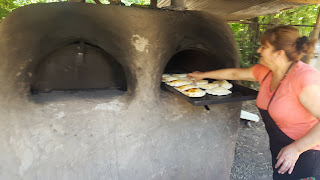Backpacking can be easy
For even those comfortable in the outdoors, backpacking, especially over multiple days, can be intimidating. The idea of carrying everything with you and carrying it all on your back is a new challenge. We feel the same way! And we are no experts. We are your average Joe Schmoe just trying to find a little adventure, pushing the edges of our own comforts in a low risk way. The good news is that backpacking, or "car camping", doesn't have to be intense or extreme - it can be attainable and even fun.
On our South America travels, we have been asked often for backpacking tips. Doesn't the equipment take up a lot of room in your luggage? Well, that depends. Of our three months of travel thus far, we have probably camped for almost a quarter of the nights, and it has allowed us to see places we wouldn't normally have seen. This has made the camping gear very much worth the extra space. The beautiful thing about traveling is that hostels and hotels are used to guests leaving bags behind, so we have utilized this to keep our backpacks light, leaving everything behind that we wouldn't need for a single trip.
What to know before you go backpacking?
Based off The 10 essential items. Check out our post on our favorite camping supplies.
Think about dry foods that cook fast in hot water. And, consider what you may be able to find in areas with limited provisions. This was a list of things that we could find in some of the limited markets in Patagonia (see photo for a sample of what we found in Puerto Natales, Chile, the main hub for Torres del Paine).
Other snacks:
On our South America travels, we have been asked often for backpacking tips. Doesn't the equipment take up a lot of room in your luggage? Well, that depends. Of our three months of travel thus far, we have probably camped for almost a quarter of the nights, and it has allowed us to see places we wouldn't normally have seen. This has made the camping gear very much worth the extra space. The beautiful thing about traveling is that hostels and hotels are used to guests leaving bags behind, so we have utilized this to keep our backpacks light, leaving everything behind that we wouldn't need for a single trip.
What to know before you go backpacking?
- Where are you going?
- How are you going to get there? Will it be a challenge to bring a fully loaded backpack with you?
- Rules of the area - Can you have a fire?
- Dangers of the area - Are there bears or other animals? Is there poison ivy off the trails?
- The expected, and unexpected weather - Are you prepared for wind? rain? snow?
- Basic survival skills
Based off The 10 essential items. Check out our post on our favorite camping supplies.
- Sleeping bag (light and compressible)
- Tent with a rain fly
- Stove, pot, and gasoline (or method for fire)
- Matches and/or lighter
- Bowl, cup, eating utensil
- Head lamp
- Toilet paper
- Hand sanitizer
- Bag or other for trash (pack it out, people!)
- Compass, map, or other method for wayfinding
- Wet wipes
- Pillow
- Coffee making goods
- Sleeping mat/pad
Think about dry foods that cook fast in hot water. And, consider what you may be able to find in areas with limited provisions. This was a list of things that we could find in some of the limited markets in Patagonia (see photo for a sample of what we found in Puerto Natales, Chile, the main hub for Torres del Paine).
- Couscous
- Pasta
- Rice (instant is fastest)
- Lentils (takes awhile, but possible if gas is not a problem)
- Dry soup mix
- Spices! Really essential to make everything taste so much better. If you are limited, we recommend salt, cumin, and cayenne or curry powder.

Other snacks:
- Protein bars (when I can, I make these: 5 Ingredient Granola Bars)
- Fruit that doesn't bruise easily (We prefer apples or oranges)
- Processed meat
- Hard cheeses
- Nuts and dried fruit
- Pitas or tortillas
- Nutella or other nut butter types spreads



Comments
Post a Comment